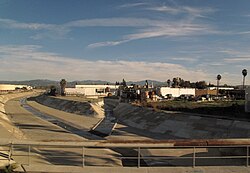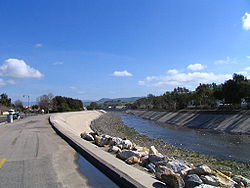
This is a list of rivers of Orange County, California , part of the Greater Los Angeles Area in Southern California.The Santa Ana River and San Gabriel River are the largest in Orange County; their extensive watersheds extend into neighboring Los Angeles, Riverside and San Bernardino Counties. A number of smaller streams originate in or flow largely within Orange County, chief of which are Coyote Creek, Santiago Creek, San Diego Creek, Aliso Creek, and San Juan Creek. Many streams in the area received their names from Spanish explorers in the 18th century.
Contents
- San Gabriel River watershed
- Anaheim Bay watershed
- Santa Ana River watershed
- Newport Bay watershed
- Aliso Creek watershed
- San Juan Creek watershed
- San Mateo Creek watershed
- Coastal streams
- Notes
- References
- See also
- External links
With the exception of mountain regions, Orange County is characterized by dense suburban and urban development. To protect the county's 3 million people from floods, many streams were channelized and/or lined with concrete in the 20th century. In addition, some wholly artificial streams were constructed to drain the large coastal wetlands and floodplains in north Orange County, namely in the Anaheim Bay watershed. Although the purpose of channelization is to carry floodwaters to the sea in an efficient manner, Orange County's streams have also been impacted by stormwater capture projects, to reduce the county's reliance on imported water. Such projects range from Irvine Lake – the county's largest body of fresh water, created by damming Santiago Creek in 1931 – to the extensive Santa Ana River groundwater recharge operations that provide as much as half the domestic water used in the county.
| Watershed | Total area | Area within Orange County | %Total OC land area |
|---|---|---|---|
| Aliso Creek [1] | 22,400 acres (91 km2) | 22,400 acres (91 km2) | 4.38% |
| Anaheim Bay– Huntington Harbor [2] | 51,422 acres (208 km2) | 51,422 acres (208 km2) | 10.06% |
| Newport Bay [3] | 97,293 acres (394 km2) | 97,293 acres (394 km2) | 19.02% |
| San Gabriel River [4] [5] | 440,960 acres (1,786 km2) | 53,760 acres (218 km2) | 10.51% |
| San Juan Creek [6] [7] | 112,640 acres (456 km2) | 102,387 acres (415 km2) | 20.02% |
| San Mateo Creek [8] [9] | 88,960 acres (360 km2) | 12,262 acres (50 km2) | 2.39% |
| Santa Ana River [10] [11] | 1,696,000 acres (6,869 km2) | 134,701 acres (546 km2) | 26.34% |





